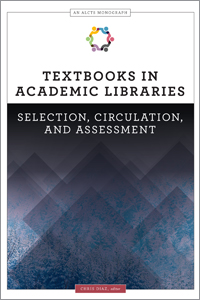Primary tabs
You don't need to be an ALA Member to purchase from the ALA Store, but you'll be asked to create an online account/profile during the checkout to proceed. This Web Account is for both Members and non-Members.
If you are Tax-Exempt, please verify that your account is currently set up as exempt before placing your order, as our new fulfillment center will need current documentation. Learn how to verify here.
- Description
- Table of Contents
- About the authors
- Reviews
Shortly after the syllabi are posted, and long before the beginning of the term, interlibrary loan departments at academic libraries will have filled or rejected innumerable textbook requests. While it would be unwise if not impossible to buy and circulate every textbook at a college or university, there are many academic libraries who are selectively adding textbooks to their collections. And the practice seems to be gaining momentum. In this volume, the Association for Library Collections and Technical Services (ALCTS) and editor Chris Diaz gather case studies that pull together creative approaches and best practices for print textbook reserve programs. This book discusses such topics as
- results and analysis from a detailed survey of a state university’s core-course textbook reserve program;
- funding sources for starting or piloting a program;
- using aggregated enrollment, grade, and textbook cost data to identify "high impact" courses;
- identifying course-related books that are in the library’s collection or fit an existing collection policy;
- workflow for using bookstore data with ILS and purchasing systems; and
- using LibGuides and Google Sheets to publicize textbook holdings, and how a back-end database supports discovery for students and reporting for reserves staff.
A textbook reserve program can be one way of helping students who are struggling with the high cost of textbooks, and this book spotlights a variety of examples that can be used as models.
Introduction
Chapter One "Basically Everything I Need, I Know the Library Has It": A Case Study of SUNY Canton’s Textbook Program
by Rachel A. Koenig and Cori Wilhelm
Chapter Two Access and Affordability: The Textbook Conundrum
by Peggy Seiden and Amy McColl
Chapter Three The Good and the Bad: Implementing a Textbook Reserve Program
by Renee Le Beau-Ford and Joanna Ewing
Chapter Four A Student-Funded Textbook Reserve Program
by Joanna Duy, Kirsten Huhn, and Dubravka Kapa
Chapter Five Building a STEM Collection of Undergraduate Textbooks
by Pattie Piotrowski and Christine McClure
Chapter Six Evolution of a Textbook Circulation Program: Outcomes of Demand-Driven versus Strategic Selection Policies
by Posie Aargaard and Jan H. Kemp
Chapter Seven Can Hard-Copy Textbooks on Library Reserve Help Address the Textbook Dilemma?
by Feng-Ru Sheu, Kay Downey, and Tom Klingler
Chapter Eight Walking the Tightrope: Balancing Students’ Desire for Textbooks and the Library Budget
by Rhonda Glazier and Carla Myers
Chapter Nine General Education: Ten Years of Textbooks at the Ohio State University Libraries
by Aaron Olivera
About the Contributors
Index
Chris Diaz
Chris Diaz is the digital publishing services librarian at Northwestern University (Evanston, Illinois), where he manages the institutional repository and the library's digital publishing program. He became interested in college textbooks and open educational resources when he was the collections management librarian at National Louis University (Chicago).
Core
The former Association for Library Collections and Technical Services (ALCTS), the Library Information Technology Association (LITA), and the Library Leadership and Management Association (LLAMA) are now Core: Leadership, Infrastructure, Futures, a new division of ALA. Its mission is to cultivate and amplify the collective expertise of library workers in core functions through community building, advocacy, and learning.
"This book will be of interest to all academic libraries struggling through these questions and challenges."
— ARBA
"All engagingly written, the chapters stand on their own perfectly well, but when they are taken together and viewed as a whole, Textbooks in Academic Libraries provides a remarkably broad survey of current practices and possibilities for libraries considering a textbook collection."
— Technicalities
"Many of these studies offer a blueprint on how to manage a program start to finish, and they all offer their own insights and experience that are helpful to any library considering this program. This book is a must-read for any library interested in building or retooling a textbook reserve program as it offers fresh insight into strategies for maintaining the program and where the conversations should go from there."
— LRTS



